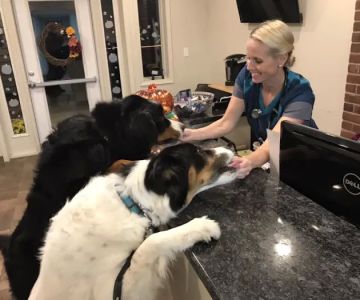Understanding the Causes of Excessive Paw Licking in Dogs
As a dog owner, one of the most perplexing behaviors I’ve encountered is when my dog constantly licks its paws. At first, it seems like just a harmless habit, but over time, I realized it could be a sign of something more serious. Dogs licking their paws excessively can point to a variety of issues. From allergies to anxiety, understanding the root cause of this behavior is the first step in solving it. Let's dive into why dogs might lick their paws and how we can help them stop this behavior.
1. Allergies: A Common Trigger for Paw Licking
Allergies are one of the most common reasons behind excessive licking. Just like us, dogs can develop allergies to a range of substances like pollen, dust mites, mold, or even certain foods. My dog, for instance, started licking his paws more during the spring months when pollen counts were high. He was obviously uncomfortable, and the licking was his way of trying to soothe the irritation. Allergies can cause inflammation in your dog's paws, leading to itching and licking.
2. Anxiety and Stress: Emotional Causes of Paw Licking
Another factor to consider is stress or anxiety. When my dog went through a period of separation anxiety, he would lick his paws excessively, sometimes even chewing on them. Dogs often turn to licking as a coping mechanism when they feel stressed. This could be due to changes in their environment, like a new family member, a move to a new home, or a change in routine. It’s important to address the emotional health of your dog to reduce anxiety-driven behaviors.
3. Infections: When Paw Licking is a Sign of Infection
Infections, whether bacterial, fungal, or parasitic, can also cause dogs to lick their paws. I learned this the hard way when my dog developed a yeast infection between his toes. His constant licking led to even more irritation, making the problem worse. Fungal infections are common in dogs with floppy ears or those that spend a lot of time outdoors. If you notice your dog’s paws are swollen, red, or have an unpleasant odor, it’s time to visit the vet for a proper diagnosis and treatment.
4. Dry Skin and Irritation: Physical Discomfort
Dry skin or irritation can make your dog’s paws feel uncomfortable, prompting them to lick. This can happen due to cold weather, hot pavement, or even harsh chemicals in cleaning products. I noticed that when my dog was walking on rough surfaces, he started licking his paws more. The constant friction and dryness from the pavement caused his paws to crack, making him want to lick them for relief.
5. Pain or Injury: When Licking is a Sign of Pain
Paw licking can also be a way for dogs to communicate discomfort from pain or injury. One time, I caught my dog licking his paw obsessively after stepping on something sharp during our walk. He had a small cut that was painful. If your dog is licking one paw in particular, it could indicate an injury that needs attention. Always check your dog's paws for cuts, splinters, or any foreign objects that might be causing pain.
How to Stop Your Dog from Licking Its Paws Excessively
Once you understand the underlying cause of the excessive licking, it’s time to take action. Here are some effective solutions that worked for me when I was dealing with my dog’s paw licking habit:
1. Regular Vet Check-ups
If you’re unsure why your dog is licking its paws, a visit to the vet is crucial. A veterinarian can diagnose whether the issue is medical, like an allergy, infection, or injury, and recommend appropriate treatments. In my case, a vet visit helped me pinpoint an allergy issue and get the right medication to manage it.
2. Allergy Management
For dogs suffering from allergies, your vet may recommend antihistamines or special medicated shampoos to help alleviate symptoms. Regular paw cleaning can also remove allergens that might be sticking to your dog’s paws. I started wiping my dog’s paws with a damp cloth after every walk, which helped reduce the allergens and prevent further licking.
3. Addressing Anxiety
To address anxiety-related licking, consider providing your dog with more mental stimulation, interactive toys, and a predictable routine. When I noticed my dog was stressed due to separation anxiety, I started leaving him with a puzzle feeder during my absence. This kept him distracted and helped reduce his licking behavior.
4. Moisturizing and Skin Care
For dogs with dry or irritated skin, applying a dog-safe moisturizer can help. My dog’s paws were often dry after winter walks, so I started using a balm recommended by my vet. This helped soothe his paws and stop the licking. You can also prevent paw irritation by avoiding rough surfaces or cleaning off any harsh chemicals after walks.
5. Preventing Access to Licking
If your dog’s licking is becoming a habit, it might help to prevent them from having access to their paws. I used an Elizabethan collar (also known as an E-collar) for a while to keep my dog from licking his paws until the underlying issue was resolved. It’s a temporary measure that can prevent further irritation and give the paws time to heal.
Conclusion: Helping Your Dog Find Relief
Excessive paw licking in dogs is often a symptom of an underlying issue, whether it’s allergies, anxiety, infection, or something else. By understanding the cause and taking appropriate steps, you can help your dog find relief and prevent further discomfort. Remember, a visit to the vet is always a good starting point, as they can provide expert advice tailored to your dog's needs. I’ve found that with patience, care, and the right approach, it's possible to help your dog stop licking their paws excessively and improve their overall well-being.











